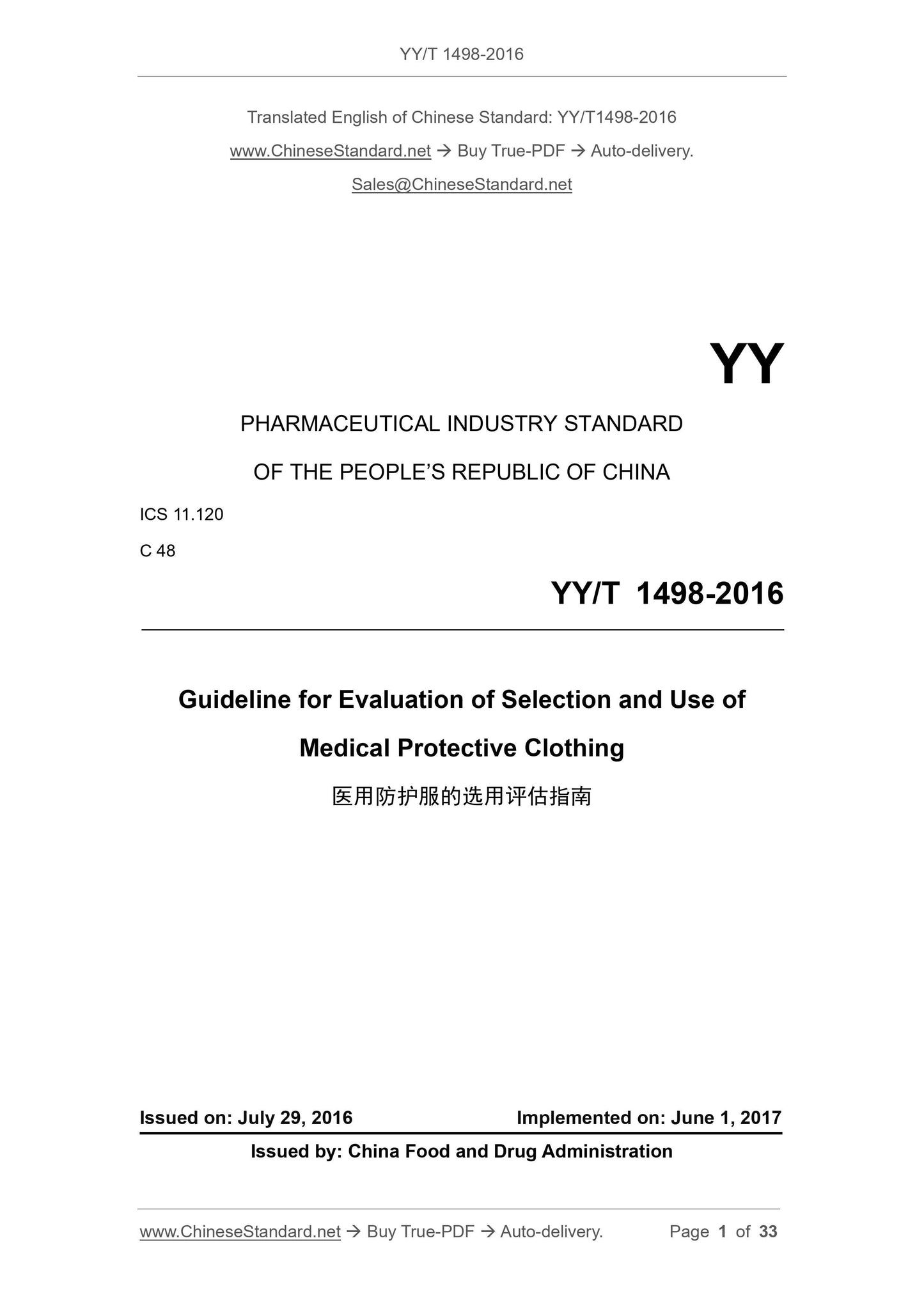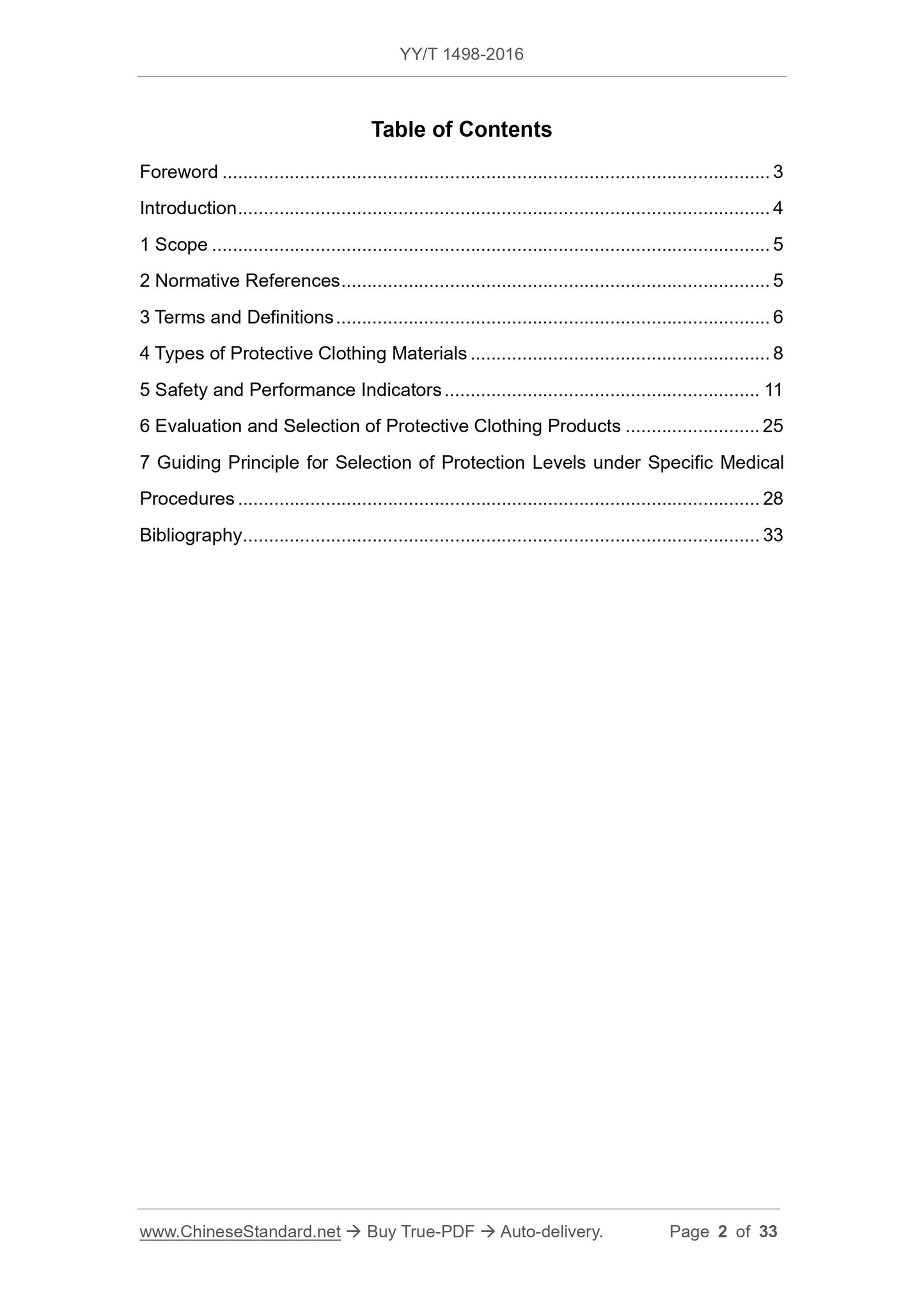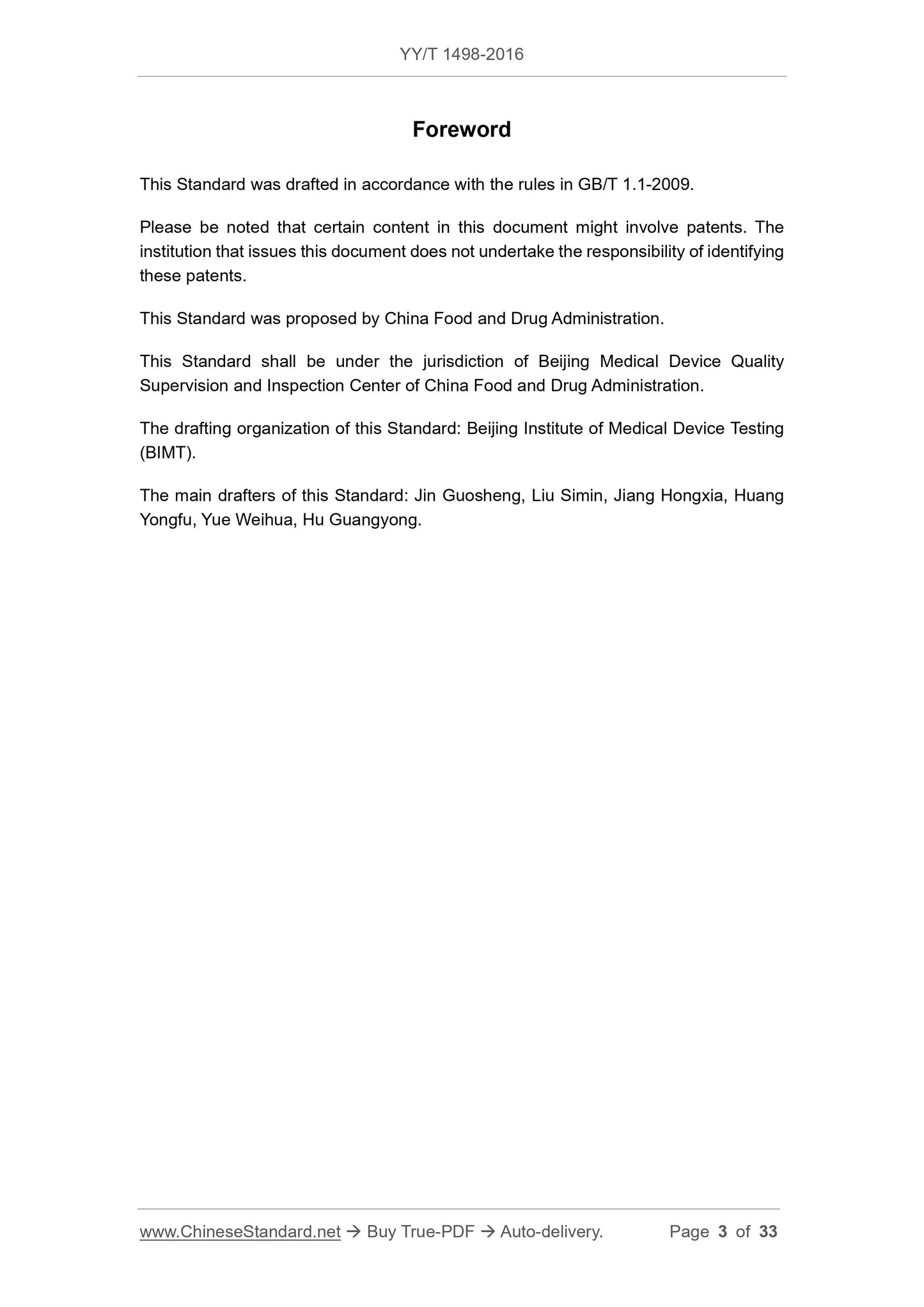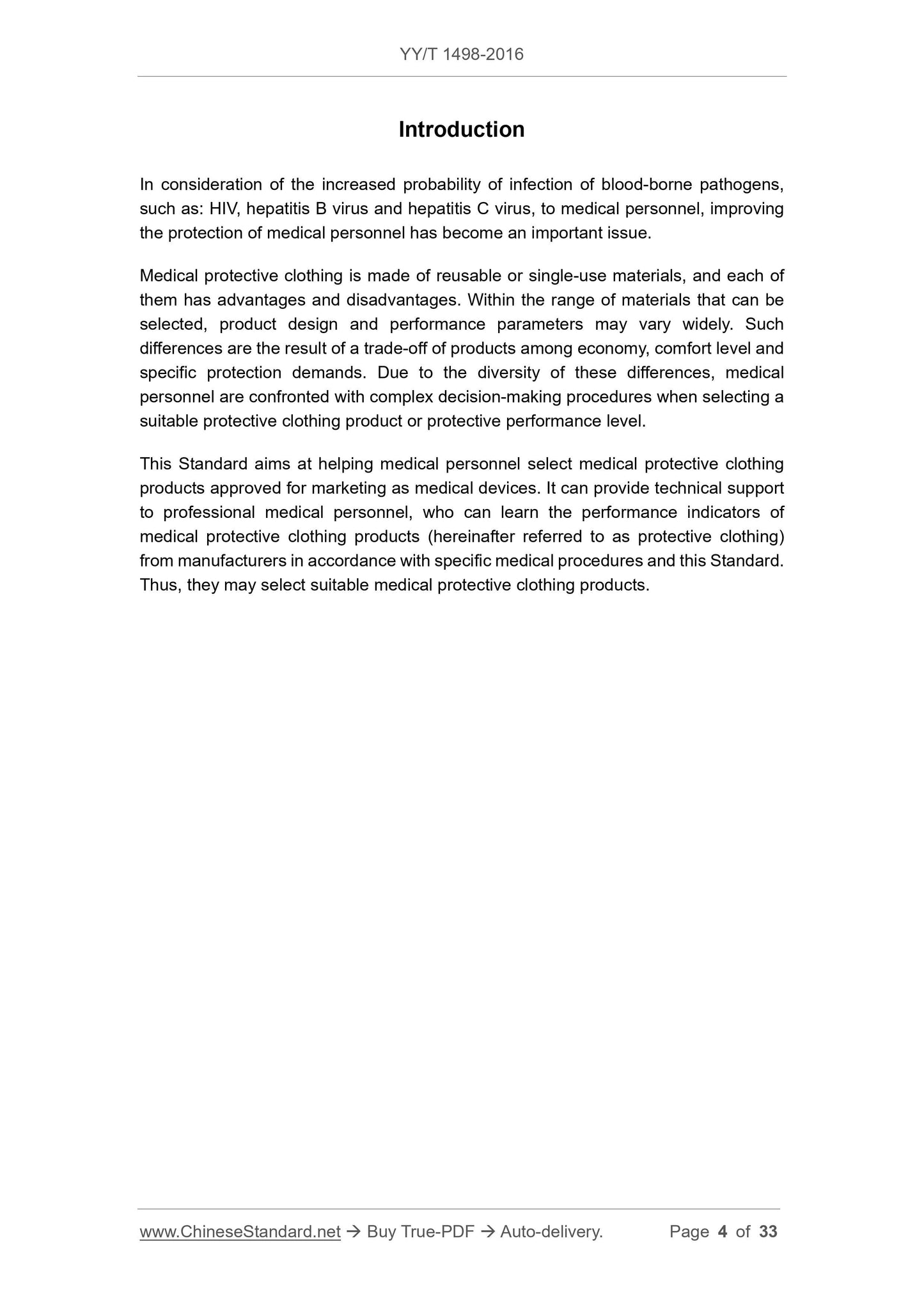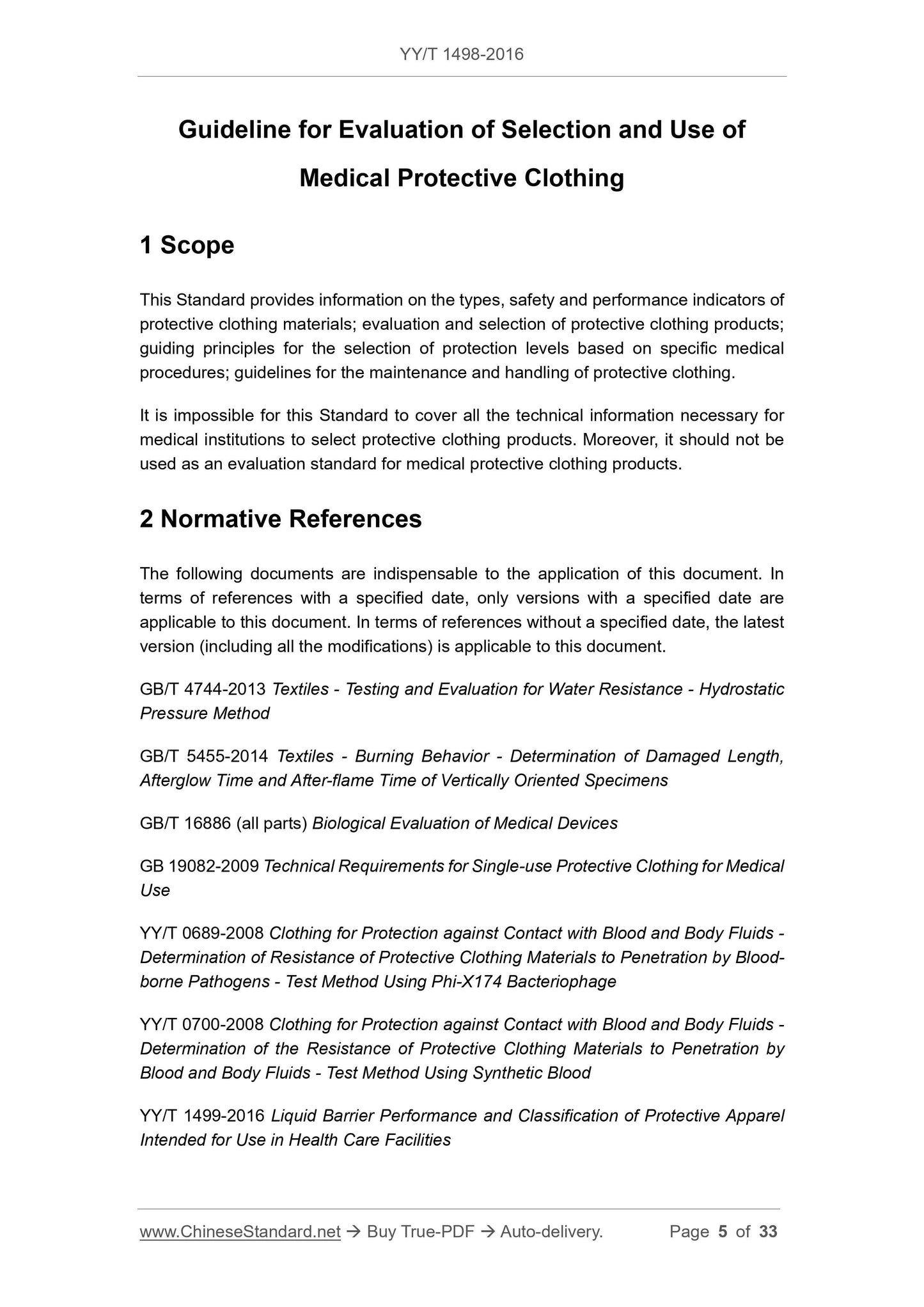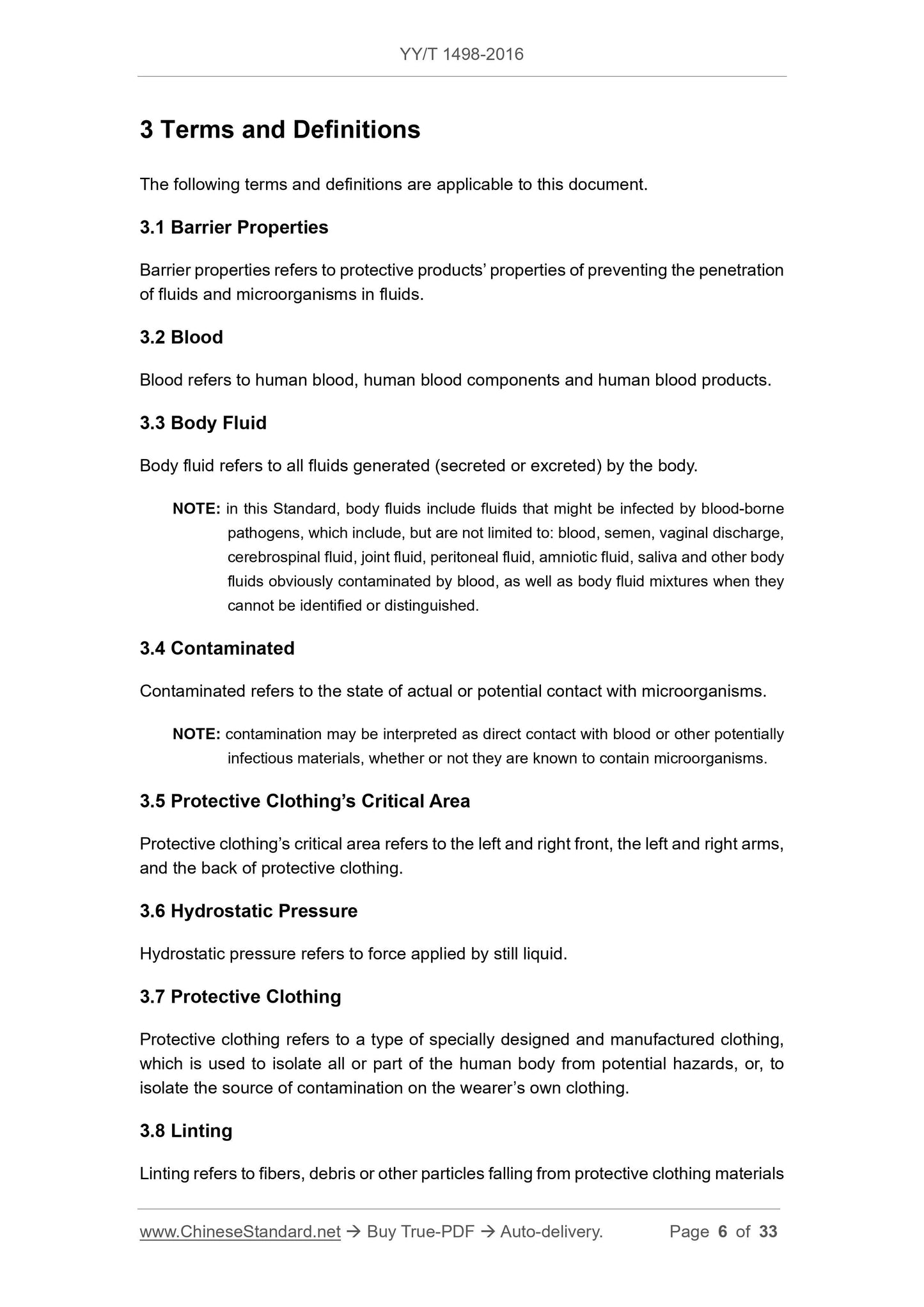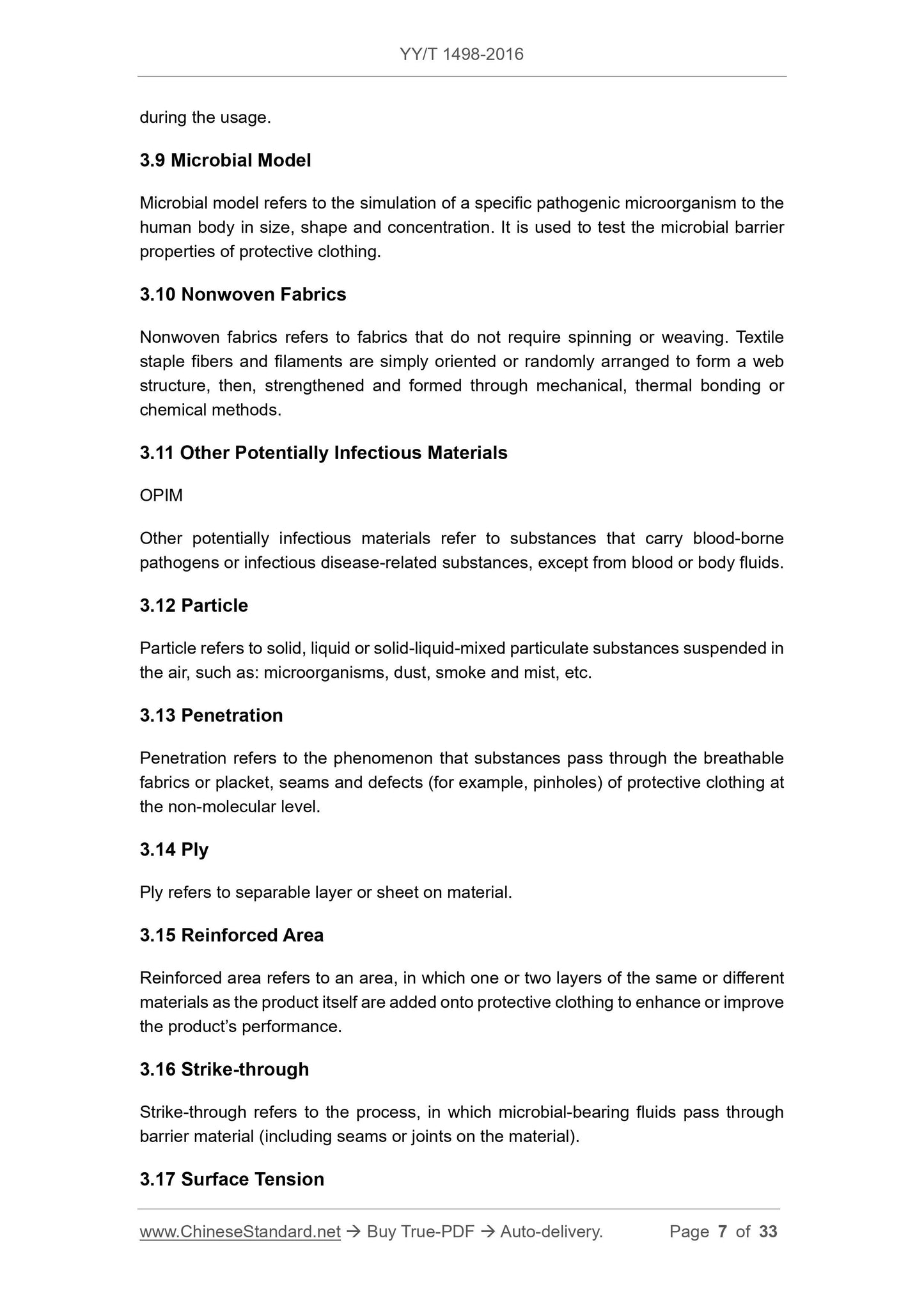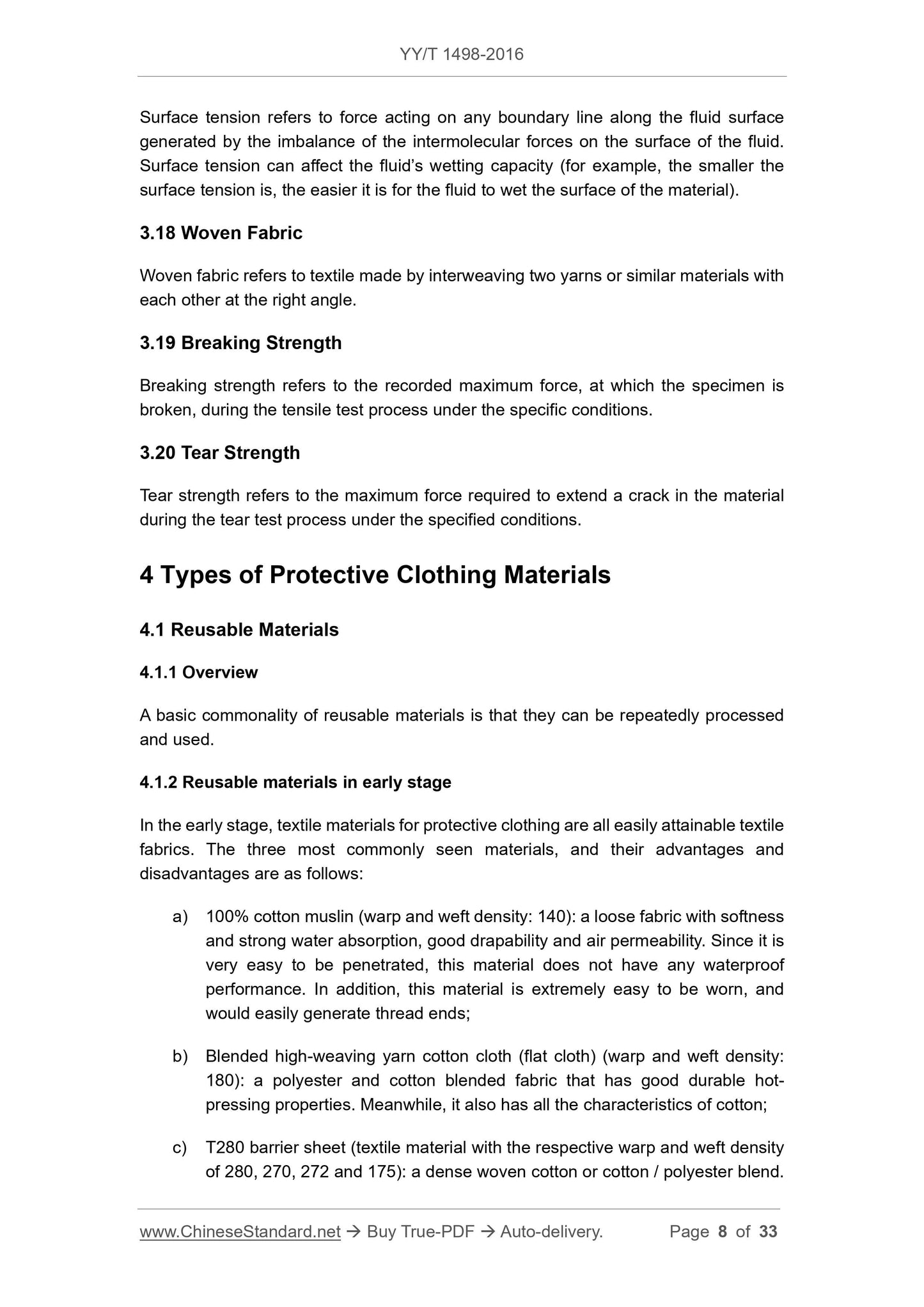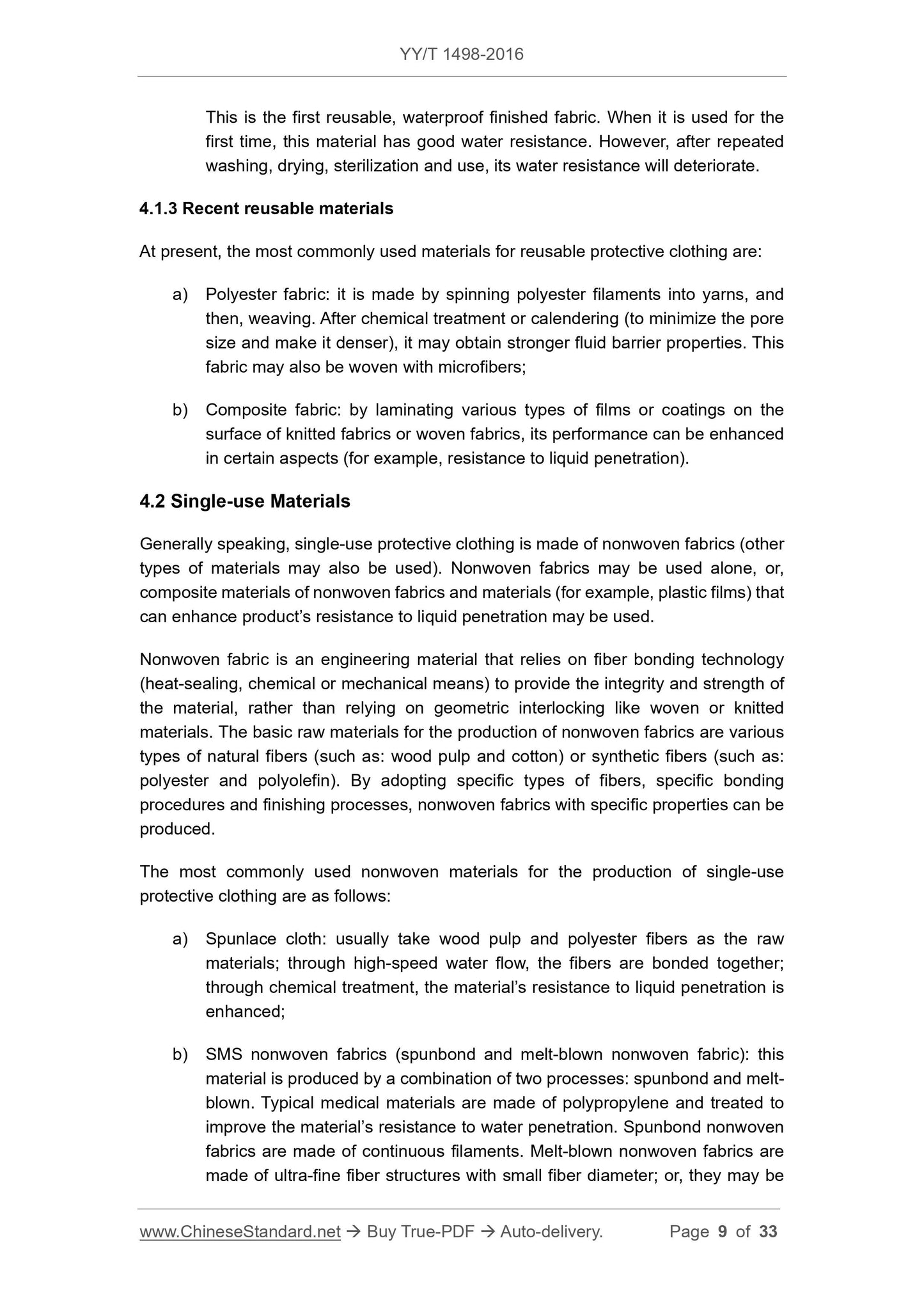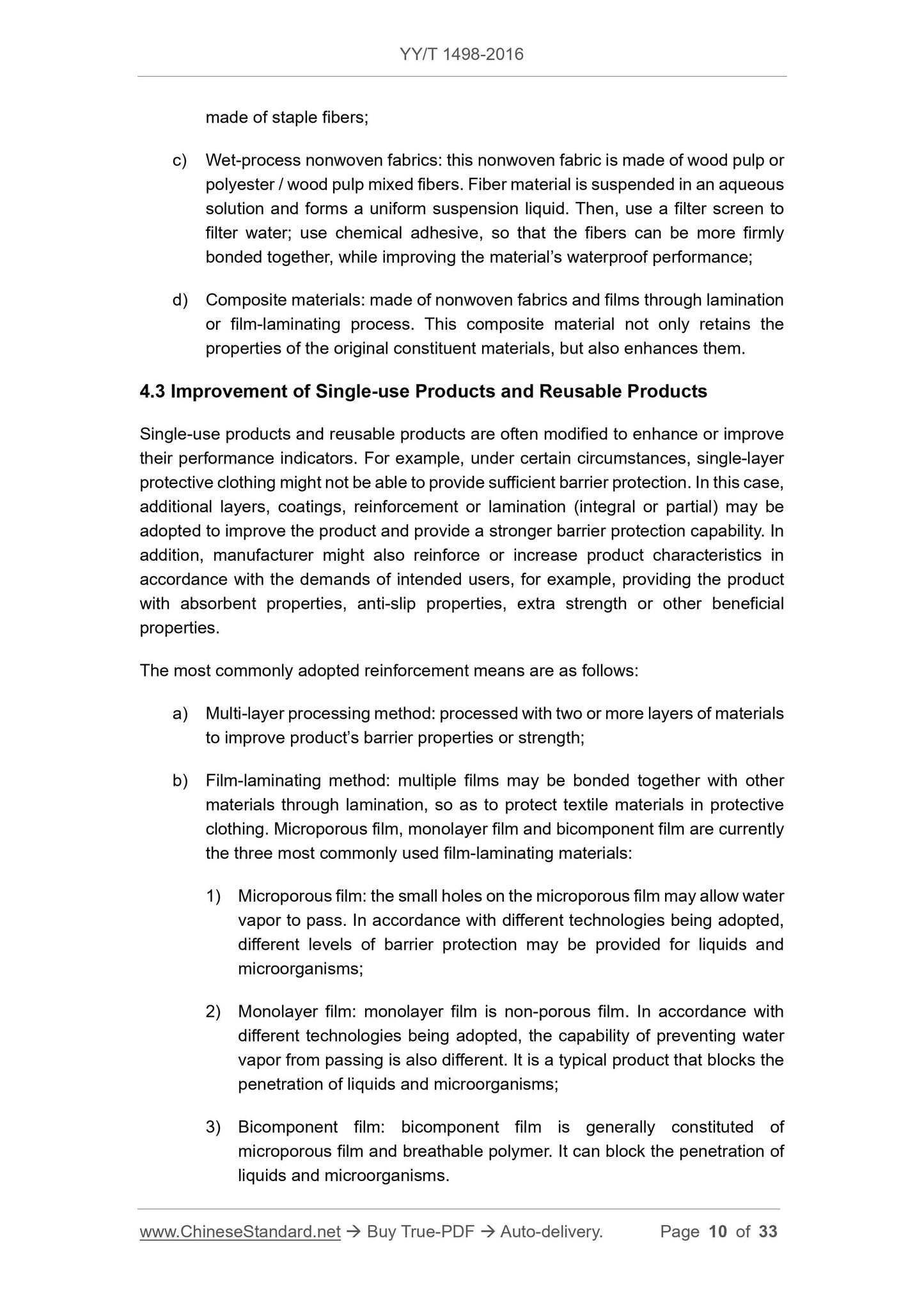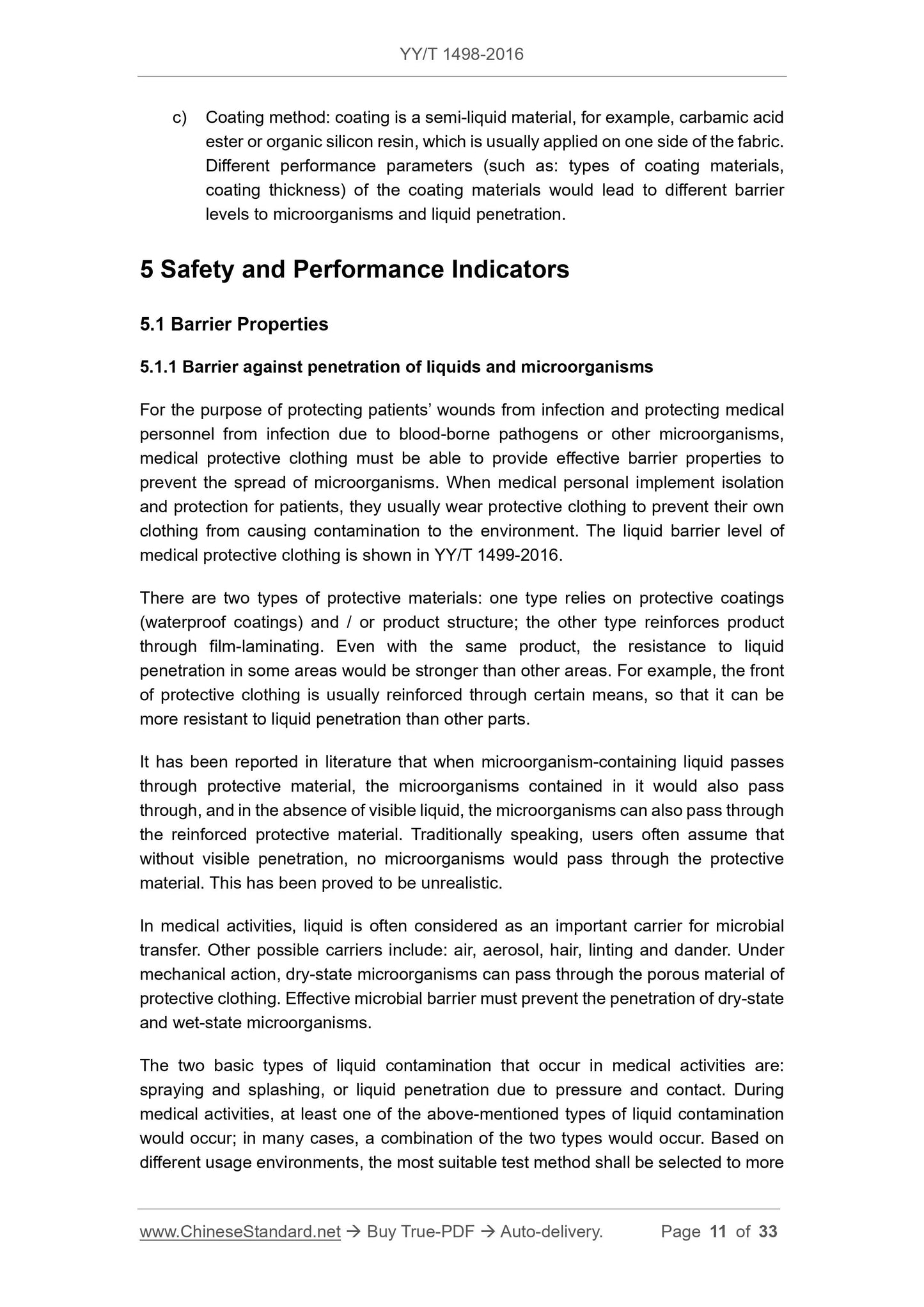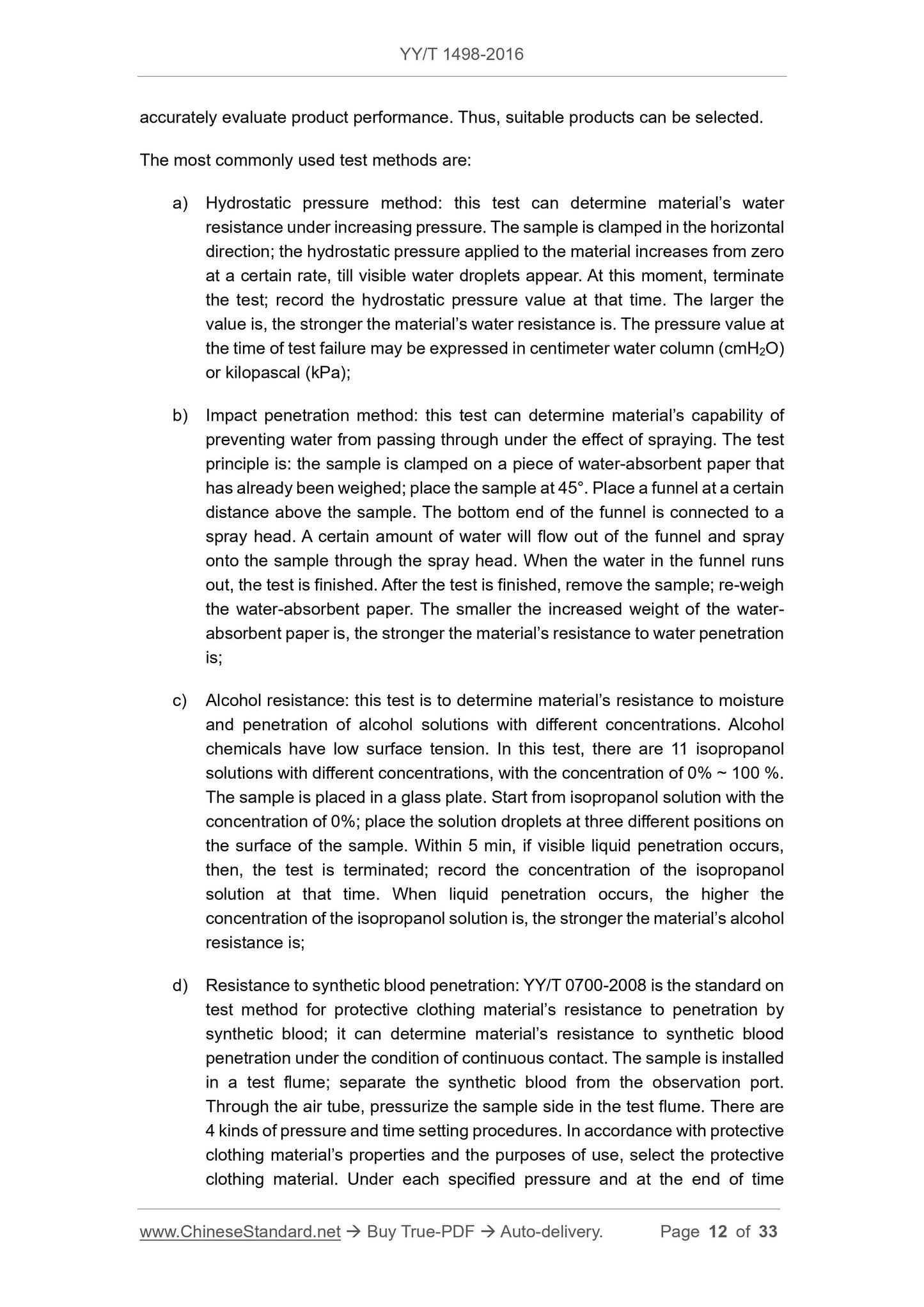PayPal, credit cards. Download editable-PDF & invoice in 1 second!
YY/T 1498-2016 English PDF (YYT1498-2016)
YY/T 1498-2016 English PDF (YYT1498-2016)
Precio habitual
$250.00 USD
Precio habitual
Precio de oferta
$250.00 USD
Precio unitario
/
por
Los gastos de envío se calculan en la pantalla de pago.
No se pudo cargar la disponibilidad de retiro
Delivery: 3 seconds. Download true-PDF + Invoice.
Get QUOTATION in 1-minute: Click YY/T 1498-2016
Historical versions: YY/T 1498-2016
Preview True-PDF (Reload/Scroll if blank)
YY/T 1498-2016: Guideline for evaluation of selection and use of medical protective clothing
YY/T 1498-2016
PHARMACEUTICAL INDUSTRY STANDARD
OF THE PEOPLE’S REPUBLIC OF CHINA
ICS 11.120
C 48
Guideline for Evaluation of Selection and Use of
Medical Protective Clothing
ISSUED ON: JULY 29, 2016
IMPLEMENTED ON: JUNE 1, 2017
Issued by: China Food and Drug Administration
Table of Contents
Foreword ... 3
Introduction ... 4
1 Scope ... 5
2 Normative References ... 5
3 Terms and Definitions ... 6
4 Types of Protective Clothing Materials ... 8
5 Safety and Performance Indicators ... 11
6 Evaluation and Selection of Protective Clothing Products ... 25
7 Guiding Principle for Selection of Protection Levels under Specific Medical
Procedures ... 28
Bibliography ... 33
Guideline for Evaluation of Selection and Use of
Medical Protective Clothing
1 Scope
This Standard provides information on the types, safety and performance indicators of
protective clothing materials; evaluation and selection of protective clothing products;
guiding principles for the selection of protection levels based on specific medical
procedures; guidelines for the maintenance and handling of protective clothing.
It is impossible for this Standard to cover all the technical information necessary for
medical institutions to select protective clothing products. Moreover, it should not be
used as an evaluation standard for medical protective clothing products.
2 Normative References
The following documents are indispensable to the application of this document. In
terms of references with a specified date, only versions with a specified date are
applicable to this document. In terms of references without a specified date, the latest
version (including all the modifications) is applicable to this document.
GB/T 4744-2013 Textiles - Testing and Evaluation for Water Resistance - Hydrostatic
Pressure Method
GB/T 5455-2014 Textiles - Burning Behavior - Determination of Damaged Length,
Afterglow Time and After-flame Time of Vertically Oriented Specimens
GB/T 16886 (all parts) Biological Evaluation of Medical Devices
GB 19082-2009 Technical Requirements for Single-use Protective Clothing for Medical
Use
YY/T 0689-2008 Clothing for Protection against Contact with Blood and Body Fluids -
Determination of Resistance of Protective Clothing Materials to Penetration by Blood-
borne Pathogens - Test Method Using Phi-X174 Bacteriophage
YY/T 0700-2008 Clothing for Protection against Contact with Blood and Body Fluids -
Determination of the Resistance of Protective Clothing Materials to Penetration by
Blood and Body Fluids - Test Method Using Synthetic Blood
YY/T 1499-2016 Liquid Barrier Performance and Classification of Protective Apparel
Intended for Use in Health Care Facilities
during the usage.
3.9 Microbial Model
Microbial model refers to the simulation of a specific pathogenic microorganism to the
human body in size, shape and concentration. It is used to test the microbial barrier
properties of protective clothing.
3.10 Nonwoven Fabrics
Nonwoven fabrics refers to fabrics that do not require spinning or weaving. Textile
staple fibers and filaments are simply oriented or randomly arranged to form a web
structure, then, strengthened and formed through mechanical, thermal bonding or
chemical methods.
3.11 Other Potentially Infectious Materials
OPIM
Other potentially infectious materials refer to substances that carry blood-borne
pathogens or infectious disease-related substances, except from blood or body fluids.
3.12 Particle
Particle refers to solid, liquid or solid-liquid-mixed particulate substances suspended in
the air, such as: microorganisms, dust, smoke and mist, etc.
3.13 Penetration
Penetration refers to the phenomenon that substances pass through the breathable
fabrics or placket, seams and defects (for example, pinholes) of protective clothing at
the non-molecular level.
3.14 Ply
Ply refers to separable layer or sheet on material.
3.15 Reinforced Area
Reinforced area refers to an area, in which one or two layers of the same or different
materials as the product itself are added onto protective clothing to enhance or improve
the product’s performance.
3.16 Strike-through
Strike-through refers to the process, in which microbial-bearing fluids pass through
barrier material (including seams or joints on the material).
3.17 Surface Tension
This is the first reusable, waterproof finished fabric. When it is used for the
first time, this material has good water resistance. However, after repeated
washing, drying, sterilization and use, its water resistance will deteriorate.
4.1.3 Recent reusable materials
At present, the most commonly used materials for reusable protective clothing are:
a) Polyester fabric: it is made by spinning polyester filaments into yarns, and
then, weaving. After chemical treatment or calendering (to minimize the pore
size and make it denser), it may obtain stronger fluid barrier properties. This
fabric may also be woven with microfibers;
b) Composite fabric: by laminating various types of films or coatings on the
surface of knitted fabrics or woven fabrics, its performance can be enhanced
in certain aspects (for example, resistance to liquid penetration).
4.2 Single-use Materials
Generally speaking, single-use protective clothing is made of nonwoven fabrics (other
types of materials may also be used). Nonwoven fabrics may be used alone, or,
composite materials of nonwoven fabrics and materials (for example, plastic films) that
can enhance product’s resistance to liquid penetration may be used.
Nonwoven fabric is an engineering material that relies on fiber bonding technology
(heat-sealing, chemical or mechanical means) to provide the integrity and strength of
the material, rather than relying on geometric interlocking like woven or knitted
materials. The basic raw materials for the production of nonwoven fabrics are various
types of natural fibers (such as: wood pulp and cotton) or synthetic fibers (such as:
polyester and polyolefin). By adopting specific types of fibers, specific bonding
procedures and finishing processes, nonwoven fabrics with specific properties can be
produced.
The most commonly used nonwoven materials for the production of single-use
protective clothing are as follows:
a) Spunlace cloth: usually take wood pulp and polyester fibers as the raw
materials; through high-speed water flow, the fibers are bonded together;
through chemical treatment, the material’s resistance to liquid penetration is
enhanced;
b) SMS nonwoven fabrics (spunbond and melt-blown nonwoven fabric): this
material is produced by a combination of two processes: spunbond and melt-
blown. Typical medical materials are made of polypropylene and treated to
improve the material’s resistance to water penetration. Spunbond nonwoven
fabrics are made of continuous filaments. Melt-blown nonwoven fabrics are
made of ultra-fine fiber structures with small fiber diameter; or, they may be
c) Coating method: coating is a semi-liquid material, for example, carbamic acid
ester or organic silicon resin, which is usually applied on one side of the fabric.
Different performance parameters (such as: types of coating materials,
coating thickness) of the coating materials would lead to different barrier
levels to microorganisms and liquid penetration.
5 Safety and Performance Indicators
5.1 Barrier Properties
5.1.1 Barrier against penetration of liquids and microorganisms
Get QUOTATION in 1-minute: Click YY/T 1498-2016
Historical versions: YY/T 1498-2016
Preview True-PDF (Reload/Scroll if blank)
YY/T 1498-2016: Guideline for evaluation of selection and use of medical protective clothing
YY/T 1498-2016
PHARMACEUTICAL INDUSTRY STANDARD
OF THE PEOPLE’S REPUBLIC OF CHINA
ICS 11.120
C 48
Guideline for Evaluation of Selection and Use of
Medical Protective Clothing
ISSUED ON: JULY 29, 2016
IMPLEMENTED ON: JUNE 1, 2017
Issued by: China Food and Drug Administration
Table of Contents
Foreword ... 3
Introduction ... 4
1 Scope ... 5
2 Normative References ... 5
3 Terms and Definitions ... 6
4 Types of Protective Clothing Materials ... 8
5 Safety and Performance Indicators ... 11
6 Evaluation and Selection of Protective Clothing Products ... 25
7 Guiding Principle for Selection of Protection Levels under Specific Medical
Procedures ... 28
Bibliography ... 33
Guideline for Evaluation of Selection and Use of
Medical Protective Clothing
1 Scope
This Standard provides information on the types, safety and performance indicators of
protective clothing materials; evaluation and selection of protective clothing products;
guiding principles for the selection of protection levels based on specific medical
procedures; guidelines for the maintenance and handling of protective clothing.
It is impossible for this Standard to cover all the technical information necessary for
medical institutions to select protective clothing products. Moreover, it should not be
used as an evaluation standard for medical protective clothing products.
2 Normative References
The following documents are indispensable to the application of this document. In
terms of references with a specified date, only versions with a specified date are
applicable to this document. In terms of references without a specified date, the latest
version (including all the modifications) is applicable to this document.
GB/T 4744-2013 Textiles - Testing and Evaluation for Water Resistance - Hydrostatic
Pressure Method
GB/T 5455-2014 Textiles - Burning Behavior - Determination of Damaged Length,
Afterglow Time and After-flame Time of Vertically Oriented Specimens
GB/T 16886 (all parts) Biological Evaluation of Medical Devices
GB 19082-2009 Technical Requirements for Single-use Protective Clothing for Medical
Use
YY/T 0689-2008 Clothing for Protection against Contact with Blood and Body Fluids -
Determination of Resistance of Protective Clothing Materials to Penetration by Blood-
borne Pathogens - Test Method Using Phi-X174 Bacteriophage
YY/T 0700-2008 Clothing for Protection against Contact with Blood and Body Fluids -
Determination of the Resistance of Protective Clothing Materials to Penetration by
Blood and Body Fluids - Test Method Using Synthetic Blood
YY/T 1499-2016 Liquid Barrier Performance and Classification of Protective Apparel
Intended for Use in Health Care Facilities
during the usage.
3.9 Microbial Model
Microbial model refers to the simulation of a specific pathogenic microorganism to the
human body in size, shape and concentration. It is used to test the microbial barrier
properties of protective clothing.
3.10 Nonwoven Fabrics
Nonwoven fabrics refers to fabrics that do not require spinning or weaving. Textile
staple fibers and filaments are simply oriented or randomly arranged to form a web
structure, then, strengthened and formed through mechanical, thermal bonding or
chemical methods.
3.11 Other Potentially Infectious Materials
OPIM
Other potentially infectious materials refer to substances that carry blood-borne
pathogens or infectious disease-related substances, except from blood or body fluids.
3.12 Particle
Particle refers to solid, liquid or solid-liquid-mixed particulate substances suspended in
the air, such as: microorganisms, dust, smoke and mist, etc.
3.13 Penetration
Penetration refers to the phenomenon that substances pass through the breathable
fabrics or placket, seams and defects (for example, pinholes) of protective clothing at
the non-molecular level.
3.14 Ply
Ply refers to separable layer or sheet on material.
3.15 Reinforced Area
Reinforced area refers to an area, in which one or two layers of the same or different
materials as the product itself are added onto protective clothing to enhance or improve
the product’s performance.
3.16 Strike-through
Strike-through refers to the process, in which microbial-bearing fluids pass through
barrier material (including seams or joints on the material).
3.17 Surface Tension
This is the first reusable, waterproof finished fabric. When it is used for the
first time, this material has good water resistance. However, after repeated
washing, drying, sterilization and use, its water resistance will deteriorate.
4.1.3 Recent reusable materials
At present, the most commonly used materials for reusable protective clothing are:
a) Polyester fabric: it is made by spinning polyester filaments into yarns, and
then, weaving. After chemical treatment or calendering (to minimize the pore
size and make it denser), it may obtain stronger fluid barrier properties. This
fabric may also be woven with microfibers;
b) Composite fabric: by laminating various types of films or coatings on the
surface of knitted fabrics or woven fabrics, its performance can be enhanced
in certain aspects (for example, resistance to liquid penetration).
4.2 Single-use Materials
Generally speaking, single-use protective clothing is made of nonwoven fabrics (other
types of materials may also be used). Nonwoven fabrics may be used alone, or,
composite materials of nonwoven fabrics and materials (for example, plastic films) that
can enhance product’s resistance to liquid penetration may be used.
Nonwoven fabric is an engineering material that relies on fiber bonding technology
(heat-sealing, chemical or mechanical means) to provide the integrity and strength of
the material, rather than relying on geometric interlocking like woven or knitted
materials. The basic raw materials for the production of nonwoven fabrics are various
types of natural fibers (such as: wood pulp and cotton) or synthetic fibers (such as:
polyester and polyolefin). By adopting specific types of fibers, specific bonding
procedures and finishing processes, nonwoven fabrics with specific properties can be
produced.
The most commonly used nonwoven materials for the production of single-use
protective clothing are as follows:
a) Spunlace cloth: usually take wood pulp and polyester fibers as the raw
materials; through high-speed water flow, the fibers are bonded together;
through chemical treatment, the material’s resistance to liquid penetration is
enhanced;
b) SMS nonwoven fabrics (spunbond and melt-blown nonwoven fabric): this
material is produced by a combination of two processes: spunbond and melt-
blown. Typical medical materials are made of polypropylene and treated to
improve the material’s resistance to water penetration. Spunbond nonwoven
fabrics are made of continuous filaments. Melt-blown nonwoven fabrics are
made of ultra-fine fiber structures with small fiber diameter; or, they may be
c) Coating method: coating is a semi-liquid material, for example, carbamic acid
ester or organic silicon resin, which is usually applied on one side of the fabric.
Different performance parameters (such as: types of coating materials,
coating thickness) of the coating materials would lead to different barrier
levels to microorganisms and liquid penetration.
5 Safety and Performance Indicators
5.1 Barrier Properties
5.1.1 Barrier against penetration of liquids and microorganisms
Share
